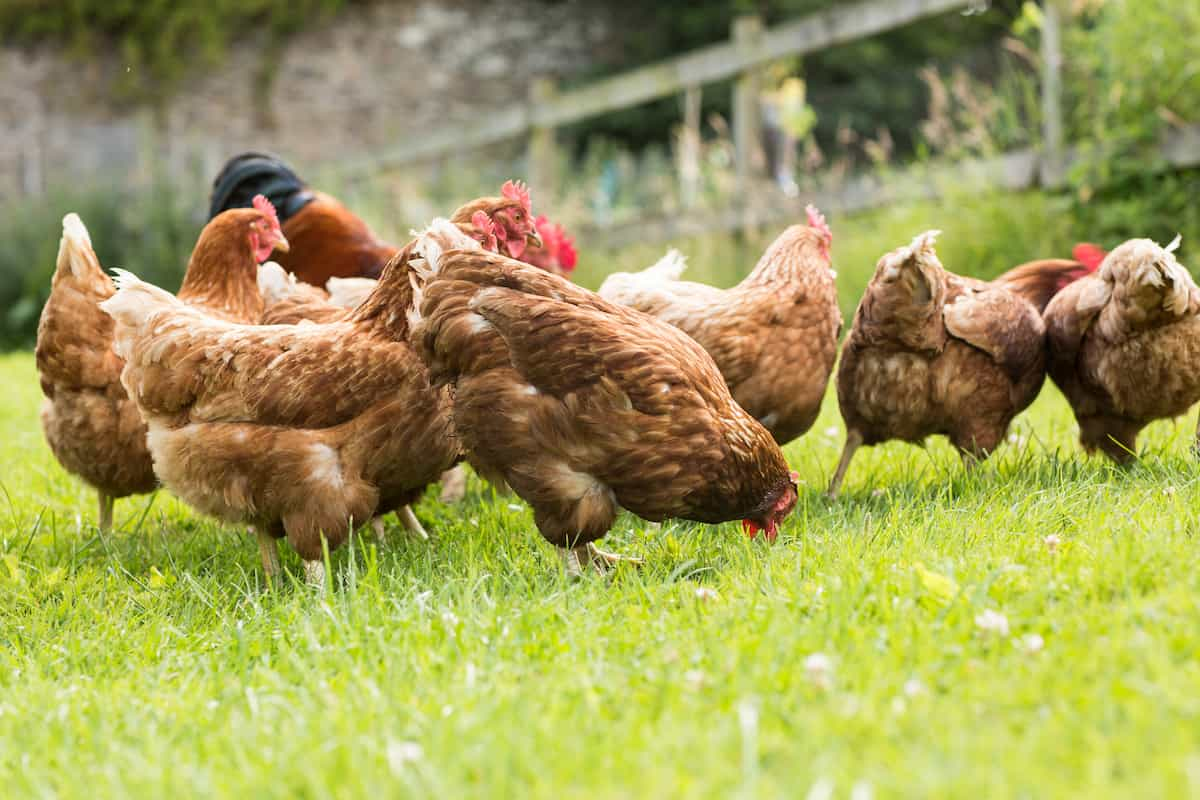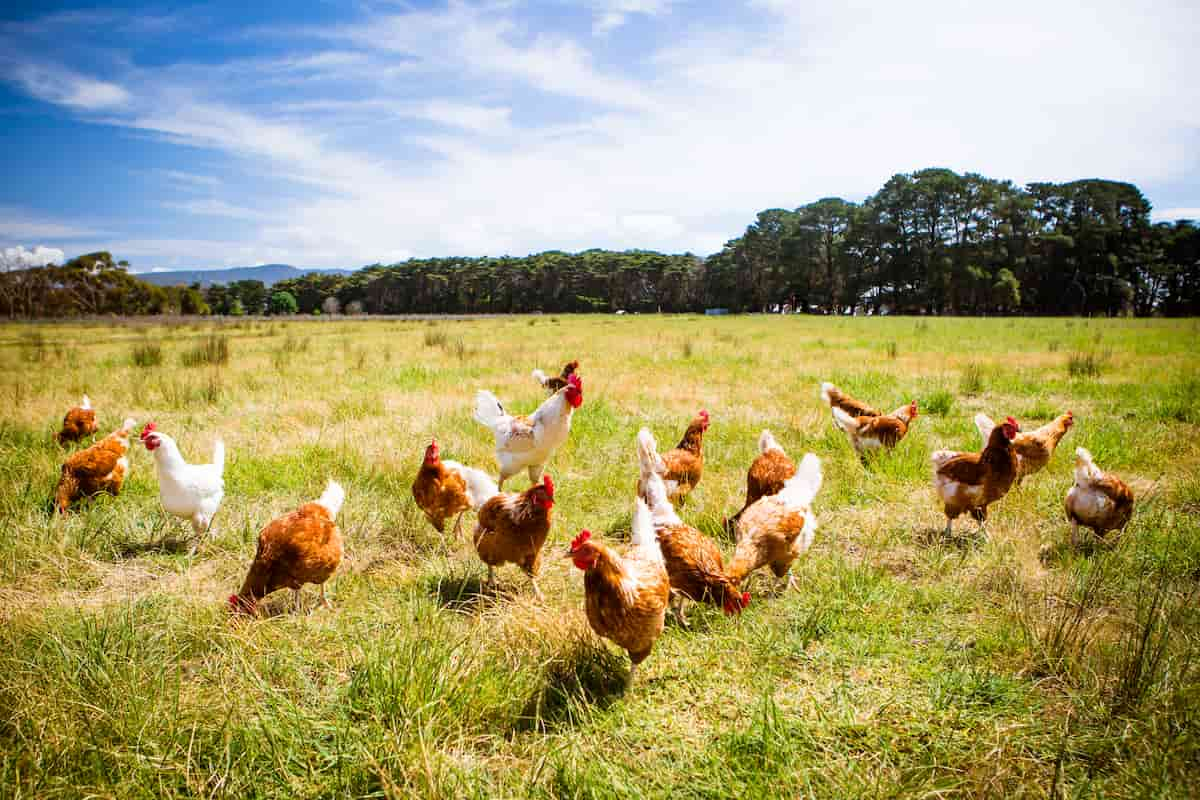Free Range Chicken Farming is a unique and sustainable approach to chicken farming. It involves raising chickens in an open environment, allowing them to roam, forage for food, and engage in natural behaviors. This method results in happier and healthier chickens and provides consumers with a premium, high-quality product. Below we learn about the free-range system in poultry and a step-by-step guide to starting a free-range poultry business plan.

Free Range Chicken Farming Business Plan
A Step-by-step Guide to Starting a Free-Range Chicken Farming Business
Land Requirements
Several variables, including flock size, chicken breed, and production techniques, determine how much land is needed for a free-range chicken farming operation. A general guideline is to provide at least 2 to 3 square feet of outdoor space per chicken and 10 to 20 square feet of indoor space per bird. This gives the chickens enough space to move around, exercise, and access food and water.
For a small-scale operation, a few acres of land is sufficient. However, for a large-scale operation, more land can be required to accommodate the larger flock and to provide enough space for the chickens to roam freely. It is important to ensure that the land is suitable for free-range chicken farming, with good access to water, pasture, and protection from predators. The land should also be properly fenced to keep the chickens safe and prevent them from escaping.
Housing Requirements
Free-range poultry housing refers to the living spaces for chickens in a free-range farming system. These living spaces provide a comfortable and safe environment for chickens to live and lay eggs. In free-range poultry housing, chickens can roam freely and forage for food within a defined area. This type of farming is designed to mimic the natural environment of chickens, promoting their physical and mental well-being.
The requirements for free-range poultry housing vary depending on the flock’s size and the area’s climate. Typically, free-range chickens need access to a coop or shelter that protects them from the elements, provides a secure place to lay eggs, and gives them a place to roost. The shed should be well-ventilated and easy to clean, and the floor should be covered in a material that allows for good drainage.
Chickens also need access to an outdoor area where they can forage for food and engage in natural behaviors. This area should be protected from predators and have adequate shade, ventilation, and access to water. The size of the outdoor area should be determined based on the number of chickens in the flock, and it should be large enough to allow for plenty of room for them to move and spread out.
In case you missed it: Broiler Chicken Farming Business Plan: Things to Consider While Starting a Poultry Farm

Equipment Required
Feeders and waterers are essential for providing food and water for your chickens. You should choose feeders and waterers that are durable, easy to clean, and capable of providing enough food and water for your flock. Incubators are necessary if you plan to incubate eggs and hatch chickens. You should choose an incubator of high quality and appropriate for the size of your flock.
Fencing is important to keep your chickens contained and protected from predators. You should choose a fencing system that is strong, durable, and appropriate for your local climate and predator populations. Nest boxes are necessary for your hens to lay their eggs. They should be secure, comfortable, and easily accessible for your hens.
Buying Day-old Chicks
Buy your day-old chicks from a reputable, accredited hatchery or business that takes good care of its parent stocks. If you’re just starting in the free-range poultry industry, you may want to find out where established farms get their chicks. The quality of the day-old chicks you purchase will impact the viability of your free-range poultry and backyard chicken company. To make a profit raising chickens free range, you’ll need a business plan that includes a budget for buying day-old chicks.
Feeding
The primary feed ingredients for free-range chickens should include high-quality grains, such as corn and wheat, and protein sources, such as soybean meal and fishmeal. Chickens also require vitamins and minerals, including calcium and phosphorus, to support their growth and health.
In addition to their primary feed, free-range chickens should also have access to pasture or a foraging area, where they can forage for insects, greens, and other natural sources of nutrition. It is important to regularly monitor the feed intake of your chickens and adjust their diet as needed to ensure that they receive a balanced and nutritious diet.
Management and labor
How many laborers you’ll need to raise your free-range and backyard chickens is entirely dependent on the scope of your business. It may just be you and your family taking care of the hens if you raise a small flock (say, 100 birds every cycle).
In contrast, you’ll need full-time staff to oversee the free-range hens if you raise more than 2,000 birds every cycle. Successful free-range chicken farming requires in-depth expertise in chicken-raising practices. Having solid managerial abilities is also essential. The free-range chicken farming enterprise should include salaries for all workers.
In case you missed it: 45 Days Chicken Business Plan: A Poultry Guide for Beginners

How Much Does Free-Range Chicken Farming Cost?
Free-range poultry farming in India requires a significant investment, as it involves the purchase of land, equipment, supplies, and chickens. How many chickens you want to grow, the scale of your farm, the equipment and materials you choose, and other variables will all affect your total cost. Investment in a free-range poultry farm in India might vary from a few lakhs to many crores of rupees.
This will include the cost of land, building infrastructure, equipment and supplies, and chickens. Additionally, you will need to budget for operating costs such as feed, utilities, and labor. It is important to thoroughly research your investment options and obtain financial guidance from experts to ensure that your investment is secure and sustainable.
Conclusion
In conclusion, the free-range chicken farming business plan is a promising investment opportunity that has the potential to generate substantial returns for investors. With the increasing demand for organic and healthy food options, the market for free-range chicken is growing at a steady pace.
A free-range chicken farming business can ensure its long-term viability and success by implementing effective management practices and adhering to the necessary regulations. With proper research and preparation, individuals can set themselves up for success in this growing industry.
- Feed Your Flock for Less: Top 10 Tips to Save on Chicken Feed
- Ultimate Guide to Ossabaw Island Hog: Breeding, Raising, Diet, and Care
- Hatching Answers: The Top 10 Reasons Your Chickens Aren’t Laying Eggs
- Eggs and Economics: Breaking Down the Cost of Raising Backyard Chickens
- Defend Your Greens: Proven Methods to Keep Iguanas Out of Your Garden
- Ultimate Guide to Cinnamon Queen Chicken: A Comprehensive Guide for Beginners
- Ultimate Guide to California Tan Chicken: Breeding, Raising, Diet, Egg-Production and Care
- Ultimate Guide to Marsh Daisy Chicken: Breeding, Raising, Diet, and Care
- 10 Types of Chicken Farming Businesses You Can Start for Profits